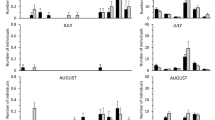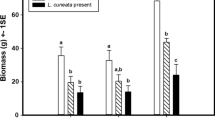Abstract
To examine the relative importance and interactions of trophic and non-trophic effects of plant invasions on herbivores, we investigated how the invasion of weeping lovegrass Eragrostis curvula impacted Eusphingonotus japonicus, a food generalist grasshopper endemic to gravelly floodplains with sparse vegetation in Japan. Field observations and laboratory experiments showed that the grasshopper fed mainly on herbs endemic to the gravelly floodplains, which were negatively impacted by the alien grass. The alien grass was not consumed as food. Field censuses also showed that the abundance of the grasshopper was positively correlated with the coverage of endemic herbs in a plot where weeping lovegrass was not dominant. Dominance of the grass (i.e., habitat modification for E. japonicus) negatively impacted the grasshopper and weakened the positive relationship between the grasshopper and endemic herbs. These results suggest that an understanding of the relationship between non-trophic and trophic effects is essential to predict the impacts of plant invasions on herbivores.


Similar content being viewed by others
References
Anderson NS (1964) Some relationships between grasshoppers and vegetation. Ann Entomol Soc Am 57:736–742
Arditi R, Michalski J, Hirzel AH (2005) Rheagogies: modelling non-trophic effects in food webs. Ecol Complex 2(3):249–258
Bock CE, Bock JH, Jepson KL, Ortega JC (1986) Ecological effects of planting African love-grasses in Arizona. Natl Geogr Res 2:456–463
Chambers P, Sword G, Angel JE, Behmer S, Bernays EA (1996) Foraging by generalist grasshoppers: two different strategies. Anim Behav 52:155–165
Committee for investigating the effects of and countermeasures against riparian exotic species (2009) Exotic species control guide, foundation for riverfront improvement and restoration, 2nd edn. Tokyo (in Japanese)
Cronin JT, Haynes KJ (2004) An invasive plant promotes unstable host-para-sitoid patch dynamics. Ecology 85(10):2772–2782
Crooks JA (2002) Characterizing ecosystem-level consequences of biological invasions: the role of ecosystem engineers. Oikos 97(2):153–166
de Groot M, Kleijn D, Jogan N (2007) Species groups occupying different trophic levels respond differently to the invasion of semi-natural vegetation by Solidago canadensis. Biol Conserv 136(4):612–617
Eades DC, Otte D (1997) Orthoptera species file online. Version 2.0/3.5. http://orthoptera.speciesfile.org. Accessed 2 February 2009
Ehleringer JR, Monson RK (1993) Evolutionary and ecological aspects of photosynthetic pathway variation. Annu Rev Ecol Syst 24:411–439
Evans EW (1992) Absence of interspecific competition among tallgrass prairie grasshoppers during a drought. Ecology 73(3):1038–1044
French K, Major RE (2001) Effect of an exotic Acacia (Fabaceae) on ant assemblages in South African fynbos. Austral Ecol 26(4):303–310
Haynes KJ, Cronin JT (2003) Matrix composition affects the spatial ecology of a prairie planthopper. Ecology 84(11):2856–2866
Heleno RH, Ceia RS, Ramos JA, Memmott J (2009) Effects of alien plants on insect abundance and biomass: a food-web approach. Conserv Biol 23(2):410–419
Hobbs RJ, Humphries SE (1995) An integrated approach to the ecology and management of plant Invasions. Conserv Biol 9(4):761–770
Japanese Meteorology Agency (2009) Monthly mean air temperature. http://www.data.jma.go.jp/obd/stats/data/en/smp/index.html. Accessed 9 April 2009
Japanese Society of Orthoptera (ed) (2006) Orthoptera of the Japanese archipelago in color. Hokkaido University Press, Sapporo (in Japanese)
Jones CG, Lawton JH, Shachak M (1994) Organisms as ecosystem engineers. Oikos 69(3):373–386
Levine JM, Vila M, D’Antonio CM, Dukes JS, Grigulis K, Lavorel S (2003) Mechanisms underlying the impacts of exotic plant invasions. P Roy Soc Lond B Bio 270(1517):775–781
Manly BFJ (1993) Comments on design and analysis of multiple-choice feeding-preference experiments. Oecologia 93(1):149–152
Matsumoto J, Muraoka H, Washitani I (2000) Whole plant carbon gain of an endangered herbaceous species Aster kantoensis and the influence of shading by an alien grass Eragrostis curvula in its gravelly floodplain habitat. Ann Bot 86(4):787–797
Mayer PM, Tunnell SJ, Engle DM, Jorgensen EE, Nunn P (2005) Invasive grass alters litter decomposition by influencing macrodetritivores. Ecosystems 8:200–209
Muranaka T, Washitani I (2001) Alien plant invasions and gravelly floodplain vegetation of Kinu River. Ecol Civil Eng 4(2):121–132 (in Japanese with Eniglish abstract)
Muranaka T, Washitani I (2004) Aggressive Invasion of Eragrostis curvla in gravelly floodplains of Japanese rivers: current status, ecological effects and countermeasures. Glob Environ Res 8(2):155–162
Pace ML, Cole JJ, Carpenter SR, Kitchell JF (1999) Trophic cascades revealed in diverse ecosystems. Trends Ecol Evol 14(12):483–488
Parker JD, Hay ME (2005) Biotic resistance to plant invasions? Native herbivores prefer non-native plants. Ecol Lett 8(9):959–967
Planty-Tabacchi AM, Tabacchi E, Naiman RJ, Deferrari C, Decamps H (1996) Invasibility of species rich communities in riparian zones. Conserv Biol 10(2):598–607
Proches S, Wilson JRU, Richardson DM, Chown SL (2008) Herbivores, but not other insects, are scarce on alien plants. Austral Ecol 33(5):691–700
Richardson DM, Holmes PM, Esler KJ, Galatowitsch SM, Stromberg JC, Kirkman SP, Pysek P, Hobbs RJ (2007) Riparian vegetation: degradation, alien plant invasions, and restoration prospects. Divers Distrib 13(1):126–139
Ritchie ME (2000) Nitrogen limitation and trophic vs. abiotic influences on insect herbivores in a temperate grassland. Ecology 81(6):1601–1612
Roa R (1992) Design and analysis of multiple-choice feeding-preference experiments. Oecologia 89(4):509–515
Rodriguez LF (2006) Can invasive species facilitate native species? Evidence of how, when, and why these impacts occur. Biol Invasions 8(4):927–939
Sage RF, Monson RK (eds) (1999) C4 plant biology. Academic Press, London
Samways MJ, Moore SD (1991) Influence of Exotic conifer patches on grasshopper (Orthoptera) assemblages in a grassland matrix at a recreational resort, Natal, South-Africa. Biol Conserv 57:117–137
Sax DF, Stachowicz JJ, Brown JH, Bruno JF, Dawson MN, Gaines SD, Grosberg RK, Hastings A, Holt RD, Mayfield MM, O’Connor MI, Rice WR (2007) Ecological and evolutionary insights from species invasions. Trends in Ecol Evol 22(9):465–471
Simpson SJ (1990) The pattern of feeding. In: Chapman RF, Joern A (eds) Biology of grasshoppers. Wiley, New York, pp 73–104
Takenaka A, Washitani I, Kuramoto N, Inoue K (1996) Life history and demographic features of Aster kantoensis, an endangered local endemic of floodplains. Biol Conserv 78(3):345–352
Takeuchi M, Fujita H (1998) Habitat status of the grasshopper, Eusphingonotus japonicus (Saussure), in Kanagawa prefecture, Japan. Jap J Appl Entomol Zool 42(4):197–200 (in Japanese with English abstract)
Tallamy DW (2004) Do alien plants reduce insect biomass? Conserv Biol 18:1689–1692
Tottori prefecture (ed) (2002) Threatened wildlife of Tottori prefecture red data book: animals. Tottori prefecture, Tottori (in Japanese)
Uchida M (2005) Decreasing grasshoppers and increasing grasshoppers. HSK, Tokyo (in Japanse)
Valtonen A, Jantunen J, Saarinen K (2006) Flora and lepidoptera fauna adversely affected by invasive Lupinus polyphyllus along road verges. Biol Conserv 133(3):389–396
Washitani I (2001) Plant conservation ecology for management and restoration of riparian habitats of lowland Japan. Popul Ecol 43(3):189–195
Washitani I (2008) Restoration of biologically-diverse floodplain wetlands including paddy fields. Glob Environ Res 12:95–99
Yoshimura C, Omura T, Furumai H, Tockner K (2005) Present state of rivers and streams in Japan. River Res Appl 21(2–3):93–112
Yoshioka A, Kadoya T, Suda S, Washitani I (2009) Impacts of weeping lovegrass (Eragrostis curvula) invasion on native grasshoppers: responses of habitat generalist and specialist species. Biol Invasions (in press). doi: 10.1007/s10530-009-9456-x
Acknowledgments
We thank the members of Nature Conservation Group of the city of Ujiie for their encouragement during the course of this study. We also thank Mr. Y. Takashima and Mr. K. Ichinose, and the other members of the laboratory of conservation ecology, the University of Tokyo, for their support during the experiments and helpful comments. Comments from two anonymous reviewers greatly improved the manuscript.
Author information
Authors and Affiliations
Corresponding author
Rights and permissions
About this article
Cite this article
Yoshioka, A., Kadoya, T., Suda, Si. et al. Invasion of weeping lovegrass reduces native food and habitat resource of Eusphingonotus japonicus (Saussure). Biol Invasions 12, 2789–2796 (2010). https://doi.org/10.1007/s10530-009-9684-0
Received:
Accepted:
Published:
Issue Date:
DOI: https://doi.org/10.1007/s10530-009-9684-0




